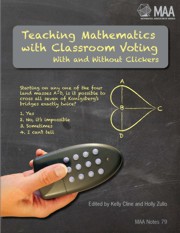Book contents
- Frontmatter
- Contents
- I An Introduction to Teaching Mathematics with Classroom Voting
- II Studies of Classroom Voting in Mathematics
- III Classroom Voting in Specific Mathematics Classes
- 6 Questions to Engage Students in Discussion (Q.E.D): Using Clickers in a Mathematics for Liberal Arts Course
- 7 Clickers in Introductory Statistics Courses
- 8 Using Clickers in a Statistics Classroom
- 9 Engaging Statistics Students with Classroom Response Systems
- 10 Incorporating Clicker Technology in the Introductory Statistics Course
- 11 Using Clickers in Courses for Future K–8 Teachers
- 12 Using Clickers in Professional DevelopmentWorkshops
- 13 Using ConcepTests in College Algebra
- 14 An Example of Multi-Purpose Use of Clickers in College Algebra
- 15 ConcepTests—Classroom Voting: A Catalyst for an Interactive College Algebra ClassroomD
- 16 Using Clickers to Encourage Communication and Self-Reflection in Precalculus
- 17 Writing and Adapting Classroom Voting Questions: New Functions from Old
- 18 Enhancing Student Participation and Attitudes in a Large-Lecture Calculus Course
- 19 Good Questions for Mathematics Eduction: An Example from Multivariable Calculus
- 20 Integrating Classroom Voting Into Your Lectures: Some Thoughts and Examples from a Differential Equations Course
- 21 Classroom Voting Questions that Provoke Teachable Moments in Differential Equations
- 22 Teaching Linear Algebra with Classroom Voting: A Class Period on Linear Independence
- 23 Lesson Planning with Classroom Voting: An Example from Linear Algebra
- 24 Using Clickers to Enhance Learning in Upper-Level Mathematics Courses
- Bibliography
- About the Editors
16 - Using Clickers to Encourage Communication and Self-Reflection in Precalculus
from III - Classroom Voting in Specific Mathematics Classes
- Frontmatter
- Contents
- I An Introduction to Teaching Mathematics with Classroom Voting
- II Studies of Classroom Voting in Mathematics
- III Classroom Voting in Specific Mathematics Classes
- 6 Questions to Engage Students in Discussion (Q.E.D): Using Clickers in a Mathematics for Liberal Arts Course
- 7 Clickers in Introductory Statistics Courses
- 8 Using Clickers in a Statistics Classroom
- 9 Engaging Statistics Students with Classroom Response Systems
- 10 Incorporating Clicker Technology in the Introductory Statistics Course
- 11 Using Clickers in Courses for Future K–8 Teachers
- 12 Using Clickers in Professional DevelopmentWorkshops
- 13 Using ConcepTests in College Algebra
- 14 An Example of Multi-Purpose Use of Clickers in College Algebra
- 15 ConcepTests—Classroom Voting: A Catalyst for an Interactive College Algebra ClassroomD
- 16 Using Clickers to Encourage Communication and Self-Reflection in Precalculus
- 17 Writing and Adapting Classroom Voting Questions: New Functions from Old
- 18 Enhancing Student Participation and Attitudes in a Large-Lecture Calculus Course
- 19 Good Questions for Mathematics Eduction: An Example from Multivariable Calculus
- 20 Integrating Classroom Voting Into Your Lectures: Some Thoughts and Examples from a Differential Equations Course
- 21 Classroom Voting Questions that Provoke Teachable Moments in Differential Equations
- 22 Teaching Linear Algebra with Classroom Voting: A Class Period on Linear Independence
- 23 Lesson Planning with Classroom Voting: An Example from Linear Algebra
- 24 Using Clickers to Enhance Learning in Upper-Level Mathematics Courses
- Bibliography
- About the Editors
Summary
Introduction
While it is imperative that future teachers of mathematics are able to have a profound understanding of mathematical ideas [53], so they are able to communicate effectively in a K–12 classroom, it is equally important that all college students communicate mathematics in an articulate and proficient manner. Future business leaders or lab technicians may use spreadsheets to do much of the heavy lifting in regards to mathematical computation in the business world, yet must still be able to convey their mathematical understanding of those numeric outputs to others on their team or the clients that employ their services. A common theme among recent documents published by the Mathematical Association of America [54], the National Council of Teachers of Mathematics [62], and the American Mathematical Association of Two-Year Colleges [1], is to provide classroom situations where students have thought-provoking and interesting conversations about mathematical topics and concepts. We have found that clickers allow us to break down some of the invisible classroom walls set up by students' discomfort communicating in front of their peers. In place of these walls, we have found students who are responsive and willing to share their thoughts and feelings about their own personal understanding of a mathematical concept. We attribute this to the fact that each student has taken a personal ownership of an answer, because of the inherent forced participation on the part of the clicker.
- Type
- Chapter
- Information
- Teaching Mathematics with Classroom VotingWith and Without Clickers, pp. 107 - 112Publisher: Mathematical Association of AmericaPrint publication year: 2011



